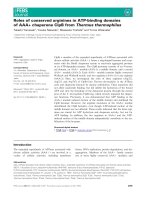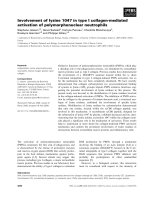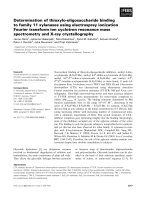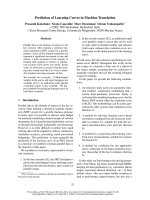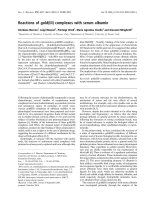Báo cáo khoa học: " Determination of Syntactic Functions in Estonian Constraint Grammar " docx
Bạn đang xem bản rút gọn của tài liệu. Xem và tải ngay bản đầy đủ của tài liệu tại đây (192.22 KB, 2 trang )
Proceedings of EACL '99
Determination of Syntactic Functions in Estonian Constraint
Grammar
Kaili Mfifirisep
Institute of Computer Science
University of Tartu
Liivi 2, 50409 Tartu
ESTONIA
kaili~ut.ee
Abstract
This article describes the current state
of syntactic analysis of Estonian using
Constraint Grammar. Constraint Gram-
mar framework divides parsing into two
different modules: morphological disam-
biguation and determination of syntac-
tic functions. This article focuses on the
last module in detail. If the morphologi-
cal disambiguator achieves the precision
more than 85% and error rate is smaller
than 2% then 80-88% of words becomes
syntactically unambiguous. The error
rate of parser is 1-4% depending on the
ambiguity rate of input. The main goal
of this work is to elaborate an efficient
parser for Estonian and annotate the
Corpus of Estonian Written Texts syn-
tactically. It is the first attempt to write
a parser for Estonian.
1 Introduction
The main idea of the Constraint Grammar (Karls-
son, 1990) is that it determines the surface-level
syntactic analysis of the text which has gone
through prior morphological analysis. The process
of syntactic analysis consists of three stages: mor-
phological disambiguation, identification of clause
boundaries, and identification of syntactic func-
tions of words. This article focuses on the last
module in detail. Grammatical features of words
are presented in the forms of tags which are at-
tached to words. The tags indicate the inflectional
and derivational properties of the word and the
word class membership, the tags attached during
the last stage of the analysis indicate its syntactic
functions. The underlying principle in determin-
ing both the morphological interpretation and the
syntactic functions is the same: first all the pos-
sible labels are attached to words and then the
ones that do not fit the context are removed by
applying special rules or constraints. Constraint
Grammar consists of hand written rules which by
checking the context decide whether an interpre-
tation is correct or has to be removed.
Constraint Grammar seemed to suit best for the
analysis of Estonian texts because its mechanism
is simple and easily implementable, it can be well
adapted for the Estonian language, it is at the
same time sufficiently reliable (robust) and the re-
sulting syntactic analysis that the Grammar gives
suits various practical applications.
2 Syntactic Analysis of Estonian
The Estonian language is a Finno-Ugric language
and has got a rich structure of declensional and
conjugational forms. The order of sentence con-
stituents in Estonian is relatively free and influ-
enced more by semantic and pragmatic factors.
For morphological analysis of Estonian, we use
the morphological analyser ESTMORF (Kaalep,
1997) that assigns adequate morphological de-
scriptions to about 98% of tokens in a text. Mor-
phologically analysed text is disambiguated by
Constraint Grammar disambiguator of Estonian.
The development of disambiguator is in process
but 85-90% of words become morphologically un-
ambiguous and the error rate of this disambigua-
tot is less than 2% (Puolakainen, 1998).
All the syntactic information is given by syntac-
tic tags in constraint grammar framework. The
syntactic tags of Estonian Constraint Grammar
(ESTCG) are derived from tag set of English
Constraint Grammar (ENGCG) (Voutilainen et
al., 1992) with some modifications considering the
specialities of Estonian. These tags are attached
to words by 175 morphosyntactic mapping rules.
After this step of parsing there are approximately
3.8 tags per word.
After the mapping operation syntactic con-
straints are applied. ESTCG contains 800 syntac-
tic constraints. In fact, nearly half of them treat
291
Proceedings of EACL '99
the attributes. It can be explained by the fact that
there are 12 types of attributes in ESTCG and the
attribute tags are also added to almost every word
in sentence (except finite verbs and conjunctions).
3 Results
To evaluate the performance of parser I use two
types of corpora. Training corpus is used for for-
mulating rules and preliminary testing. After test-
ing I improve rules so that most errors will be
fixed next time. Benchmark corpus is used only
for evaluating parser. Both types of corpora con-
sist of fiction texts. The training corpus contains
4 texts of 2000 words from different Estonian writ-
ers. Benchmark corpus consists of 2000 word. I
used these corpora in two experiments. In the first
experiment (experiment A) I tested only the syn-
tactic function detecting part of grammar and I
supposed that the input text is ideally morpho-
logically analysed and disambiguated, this means
that all words are morphologically correct and
unambiguous. For this experiment both corpora
were manually morphologically disambiguated. In
the second experiment (experiment B) I used the
same corpora but they were disambiguated au-
tomatically. In this case the disambiguator made
2% errors and left 13% of words ambiguous, 1% of
words were unknown for morphological analyser.
The precision and recall of ESTCG parser are
shown in table 1.
Table 1. Recall and precision.
Corpus Recall Precision
A Training 99,12% 83,76%
A Benchmark 98,12% 85,00%
B Training 95,76% 74,34%
B Benchmark 96,58% 76,52%
The big number of errors in B experiment can
be explained by the fact that I wrote prelimi-
nary grammar rules using only manually disam-
biguated corpora and the work on correcting rules
using more ambiguous input is still in process. As
I mentioned before the input was ambiguous and
erroneous in this experiment and this caused error
rate of 3%.
The errors in manually disambiguated corpora
are mostly caused by ellipsis, some errors occurred
during determination of apposition and the third
biggest group of errors exists in sentences there
one clause divides the other into two parts.
In experiment A, 86-88% of words become syn-
tactically unambiguous, and in experiment B, the
.corresponding numbers are 80-82%. In both ex-
periment less than 0,5% of words have 5-6 syntac-
tic tags.
It is very difficult to distinguish adverbial at-
tributes and adverbials. Approximately 6% of
analysed words have both labels. This is almost
the same problem as PP-attachment in English
but additionally it is possible to use both premod-
ifying and postmodifying adverbial attributes in
Estonian. Of course the PP-attachment problem
is also existent. The other hard problem is the dis-
tinction of genitive attributes and objects. If two
or more nouns in genitive case are situated side by
side then these words remain usually ambiguous,
e.g
siis vabastab kohus tema vara hooldaja
j~irelevalve alt. /
then free-SG3 court-NOM
he-GEN property-GEN trustee-GEN supervision-
GEN from-POSTP / ' then the court frees his
property from the supervision of trustee.'
4 Conclusions
In this paper I described my work on the syntac-
tic part of Estonian Constraint Grammar parser.
The error rate of parser is 1-4% depending on am-
biguity rate of input. 80-88% of words become
syntactically unambiguous.
The most exhaustive Constraint Grammar is
written for English. Timo J~rvinen, the author of
syntactic part of ENGCG, reported that the er-
ror rate is 2 - 2,5% and ambiguity rate ca 15%
(J~rvinen, 1994). Of course the Estonian and
English are too different languages and the com-
parison of performance of parsers do not help to
draw any fundamental conclusions. But I really
hope that the Estonian parser achieves nearly the
same performance very soon. The further work
will focus on decreasing the error rate and using
statistical analysis for generating new rules.
References
Timo J~irvinen. 1994. Annotating 200 Million
Words: The Bank of English Project. In
Proceed-
ings of COLING-94.
Vol. 1,565-568, Kyoto.
Heiki-Jaan Kaalep. 1997. An Estonian Mor-
phological Analyser and the Impact of a Corpus
on its Development.
Computers and Humanities,
31(2):115-133.
Fred Karlsson. 1990. Constraint Grammar as a
framework for parsing running text.
Proceedings
of COLING-90.
Vol. 3, 168-173, Helsinki.
Tiina Puolakainen. 1998. Developing Con-
straint Grammar for Morphological Disambigua-
tion of Estonian.
Proceedings of DIALOGUE'98.
Vol. 2, 626-630, Kazan.
Atro Voutilainen, Juha Heikkil~i and Arto
Anttila. 1992.
Constraint Grammar of English. A
Performance Oriented Introduction.
Publications
21, Department of General Linguistics, University
of Helsinki.
292



